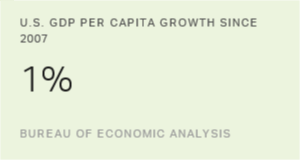WASHINGTON, D.C. -- Less than half of underemployed Americans (45%) rate their lives well enough to be considered "thriving." This compares with 60% of those who are employed who are thriving. The underemployed are significantly more likely than the employed to be "struggling" in their lives.
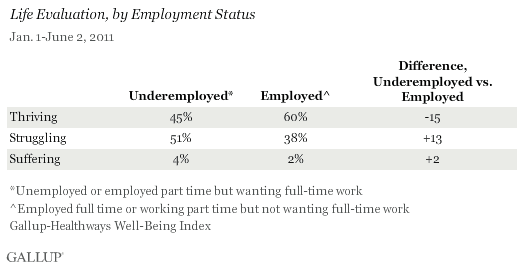
Gallup classifies the underemployed as those who are either unemployed or working part time but wanting full-time employment. Those who are working full time or working part time but not wanting full-time work are considered employed. This analysis of January through May 2011 data, collected as part of the Gallup-Healthways Well-Being Index, finds that underemployed Americans rate their lives slightly better now than they did in 2010, when 42% of the group was thriving.
When Gallup did the analysis last year, 19.8% of Americans in the workforce were underemployed; in the 2011 sample, 19.3% were in that category.
Underemployed Americans Experience More Daily Negativity Than the Employed
Daily worry and sadness are particular problems for the underemployed. One in four underemployed Americans say they experienced sadness the day before the survey, nearly double the number of employed who say the same. Forty-four percent of the underemployed experienced worry, compared with 29% of the employed.
The underemployed also experienced more anger and stress than the employed.
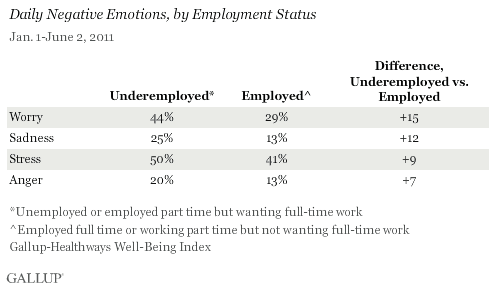
The underemployed are also significantly more likely than the employed to say they have ever been diagnosed with depression. Twenty-two percent of underemployed Americans report a depression diagnosis, higher than the national average of 17.2%.
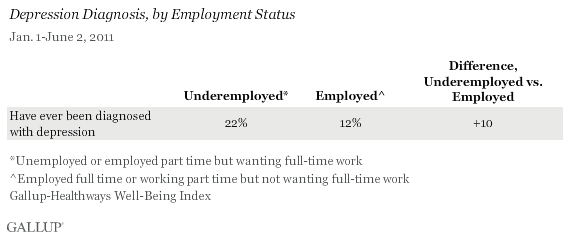
It is not clear from the data, however, whether the depression diagnosis is related to underemployed Americans' current employment status or other factors.
Underemployed Americans' Daily Positivity Lower, but Not by Much
The potential good news is that underemployed Americans' levels of enjoyment and happiness are not as affected by their employment status as their negative emotions. More than 8 in 10 underemployed Americans continue to report experiencing enjoyment and happiness "yesterday," slightly less than the percentages of the employed who say the same.
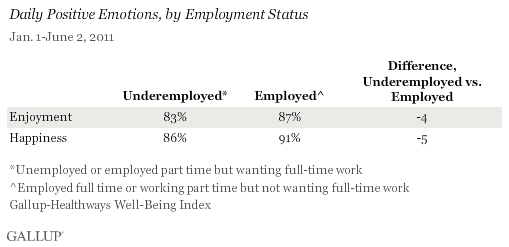
Bottom Line
Gallup found 9.2% of Americans unemployed last month and an additional 9.9% working part time but wanting full-time work, bringing the underemployment rate to 19.1%. The government's unemployment rate rose to 9.1% in May, sparking discussion in the media and among economists about whether the data point to a slowdown in the nation's economy. With millions of Americans still jobless or working less than they need or would like to and with the possibility of a further slowdown in hiring, the Gallup data underscore the negative effect underemployment can have on Americans' well-being.
The Gallup-Healthways Well-Being Index data confirm that underemployed Americans continue to rate their lives more poorly and suffer from more daily worry, sadness, stress, and anger than those who are employed. Whether an improvement in the unemployment situation could alleviate some of this angst remains to be seen. In the meantime, these data highlight that the underemployed remain a particularly vulnerable group of Americans for reasons beyond their fiscal challenges. Reducing unemployment is not only important economically, but also to improve the quality of life for the millions who are struggling to find work.
About the Gallup-Healthways Well-Being Index
The Gallup-Healthways Well-Being Index tracks U.S. and U.K. well-being and provides best-in-class solutions for a healthier world. To learn more, please visit well-beingindex.com.
Survey Methods
Results are based on telephone interviews conducted as part of the Gallup-Healthways Well-Being Index survey Jan. 1-June 2, 2011, with a random sample of 95,667 adults, aged 18 and older, who are a part of the workforce and living in all 50 U.S. states and the District of Columbia, selected using random-digit-dial sampling.
For results based on the total sample of national adults, one can say with 95% confidence that the maximum margin of sampling error is ±1 percentage point.
For results based on the sample of 18,217 underemployed adults, one can say with 95% confidence that the maximum margin of sampling error is ±1.5 percentage points. For results based on the sample of 77,450 employed respondents, one can say with 95% confidence that the maximum margin of sampling error is less than ±1 percentage point.
Interviews are conducted with respondents on landline telephones and cellular phones, with interviews conducted in Spanish for respondents who are primarily Spanish-speaking. Each sample includes a minimum quota of 400 cell phone respondents and 600 landline respondents per 1,000 national adults, with additional minimum quotas among landline respondents for gender within region. Landline telephone numbers are chosen at random among listed telephone numbers. Cell phone numbers are selected using random-digit-dial methods. Landline respondents are chosen at random within each household on the basis of which member had the most recent birthday.
Samples are weighted by gender, age, race, Hispanic ethnicity, education, region, adults in the household, and phone status (cell phone only/landline only/both, cell phone mostly, and having an unlisted landline number). Demographic weighting targets are based on the March 2010 Current Population Survey figures for the aged 18 and older non-institutionalized population living in U.S. telephone households. All reported margins of sampling error include the computed design effects for weighting and sample design.
In addition to sampling error, question wording and practical difficulties in conducting surveys can introduce error or bias into the findings of public opinion polls.
For more details on Gallup's polling methodology, visit www.gallup.com.
